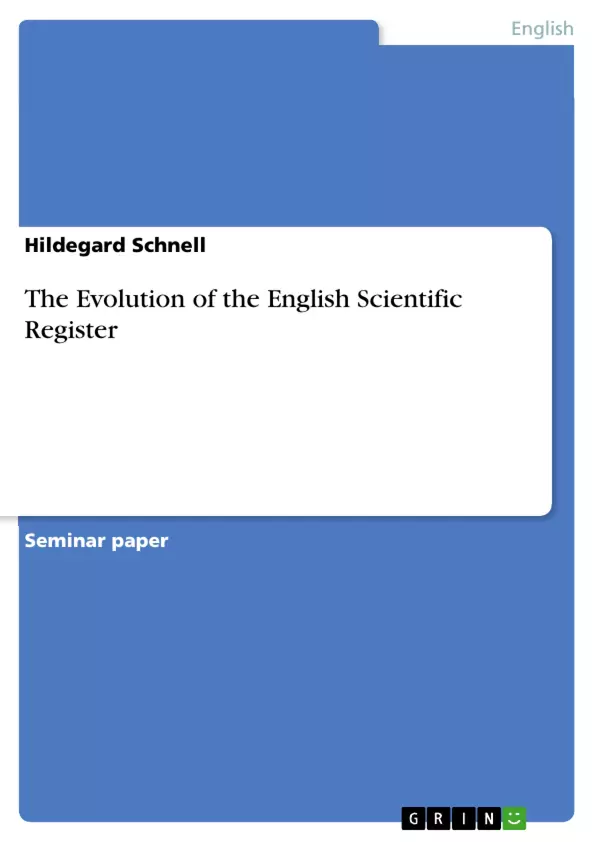Between the early stages of scientific writing in the late Middle English period and today, there have been significant changes in the grammatical properties and the rhetorical strategies of scientific discourse. These developments had an influence on the style of scientific writing, resulting in the change from a narrative towards a more argumentative style. According to this, the purpose of the present essay is to consider, from a historical stance, the evolution of linguistic features in the English scientific register. Thus, the essay takes into account several examples of linguistic features which are characteristic of late Middle English and Early Modern English scientific writing. Based on these examples, it is further the aim of my essay to provide an overview of the evolution of the English scientific register concerning its grammatical properties and rhetorical strategies up to the present day.
Inhaltsverzeichnis (Table of Contents)
- Introduction
- The process of standardisation and vernacularisation from late Middle English to Early Modern English
- English versus Latin
- The role of translation
- Evolution of the English scientific register
- Term definition: SCIENTIFIC ENGLISH
- Contextual dimensions in the production and transmission of early scientific writing
- Evolution of linguistic features in the organisation of scientific discourse
- Evolution of emotive features in scientific writing
- Evolution in the scale from learned to popular forms of scientific writing
- Evolution in patterns of agentivity and narrativity in scientific writing
- Evolution in the principles of botanical discourse organisation
- Evolution of scientific prose
- Conclusion
Zielsetzung und Themenschwerpunkte (Objectives and Key Themes)
This essay examines the evolution of the English scientific register from the late Middle English period to the present day. It aims to analyze the changes in grammatical properties and rhetorical strategies that occurred during this period, focusing on the shift from narrative to argumentative styles in scientific writing.
- The process of standardisation and vernacularisation of English
- The influence of Latin on English scientific writing
- The evolution of linguistic features in scientific discourse, including emotive features, the scale from learned to popular forms, patterns of agentivity and narrativity, and the principles of botanical discourse organisation
- The development of a distinct scientific prose style
- The role of translation in shaping the English scientific register
Zusammenfassung der Kapitel (Chapter Summaries)
The introduction provides an overview of the essay's objectives and the key themes that will be explored. It highlights the shift in scientific writing from a narrative to a more argumentative style during the period under study.
The second chapter examines the process of standardisation and vernacularisation of English from late Middle English to Early Modern English. It discusses the influence of West Saxon, the Norman Conquest, and the rise of the Chancery Standard. This section also analyzes the influence of Latin on English scientific writing.
Chapter three delves into the evolution of the English scientific register, defining the term "scientific English" and exploring the contextual dimensions of early scientific writing. The chapter further examines the evolution of linguistic features in the organisation of scientific discourse, including changes in emotive features, the scale from learned to popular forms, patterns of agentivity and narrativity, and the principles of botanical discourse organisation.
Chapter four focuses on the evolution of scientific prose, exploring the development of a distinct style of scientific writing.
Schlüsselwörter (Keywords)
This essay focuses on the evolution of the English scientific register, exploring key themes such as standardisation and vernacularisation, Latin influence, linguistic features, scientific prose, and the role of translation.
- Quote paper
- Hildegard Schnell (Author), 2009, The Evolution of the English Scientific Register, Munich, GRIN Verlag, https://www.grin.com/document/128944



